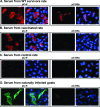Rift valley fever virus lacking the NSs and NSm genes is highly attenuated, confers protective immunity from virulent virus challenge, and allows for differential identification of infected and vaccinated animals
- PMID: 18199647
- PMCID: PMC2258974
- DOI: 10.1128/JVI.02501-07
Rift valley fever virus lacking the NSs and NSm genes is highly attenuated, confers protective immunity from virulent virus challenge, and allows for differential identification of infected and vaccinated animals
Abstract
Rift Valley fever (RVF) virus is a mosquito-borne human and veterinary pathogen associated with large outbreaks of severe disease throughout Africa and more recently the Arabian peninsula. Infection of livestock can result in sweeping "abortion storms" and high mortality among young animals. Human infection results in self-limiting febrile disease that in approximately 1 to 2% of patients progresses to more serious complications including hepatitis, encephalitis, and retinitis or a hemorrhagic syndrome with high fatality. The virus S segment-encoded NSs and the M segment-encoded NSm proteins are important virulence factors. The development of safe, effective vaccines and tools to screen and evaluate antiviral compounds is critical for future control strategies. Here, we report the successful reverse genetics generation of multiple recombinant enhanced green fluorescent protein-tagged RVF viruses containing either the full-length, complete virus genome or precise deletions of the NSs gene alone or the NSs/NSm genes in combination, thus creating attenuating deletions on multiple virus genome segments. These viruses were highly attenuated, with no detectable viremia or clinical illness observed with high challenge dosages (1.0 x 10(4) PFU) in the rat lethal disease model. A single-dose immunization regimen induced robust anti-RVF virus immunoglobulin G antibodies (titer, approximately 1:6,400) by day 26 postvaccination. All vaccinated animals that were subsequently challenged with a high dose of virulent RVF virus survived infection and could be serologically differentiated from naïve, experimentally infected animals by the lack of NSs antibodies. These rationally designed marker RVF vaccine viruses will be useful tools for in vitro screening of therapeutic compounds and will provide a basis for further development of RVF virus marker vaccines for use in endemic regions or following the natural or intentional introduction of the virus into previously unaffected areas.
Figures



References
-
- Anderson, G. W., Jr., J.-O. Lee, A. O. Anderson, N. Powell, J. A. Mangiafico, and G. Meadors. 1991. Efficacy of a Rift Valley fever virus vaccine against an aerosol infection in rats. Vaccine 9710-714. - PubMed
-
- Anderson, G. W., Jr., and C. J. Peters. 1988. Viral determinants of virulence for Rift Valley fever (RVF) in rats. Microb. Pathog. 5241-250. - PubMed
-
- Anderson, G. W., Jr., J. A. Rosebrock, A. J. Johnson, G. B. Jennings, and C. J. Peters. 1991. Infection of inbred rat strains with Rift Valley fever virus: development of a congenic resistant strain and observations on age-dependence of resistance. Am. J. Trop. Med. Hyg. 44475-480. - PubMed
Publication types
MeSH terms
Substances
LinkOut - more resources
Full Text Sources
Other Literature Sources

